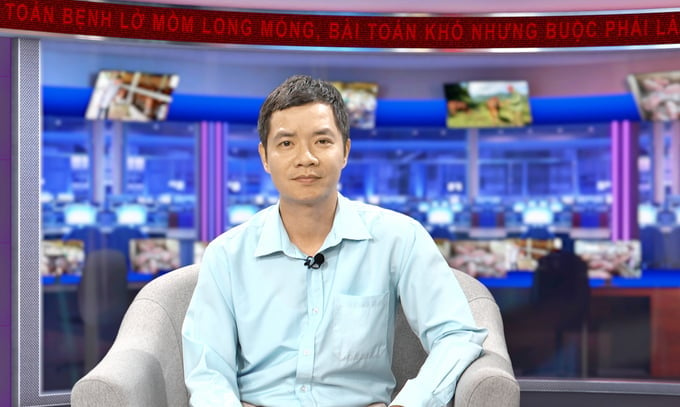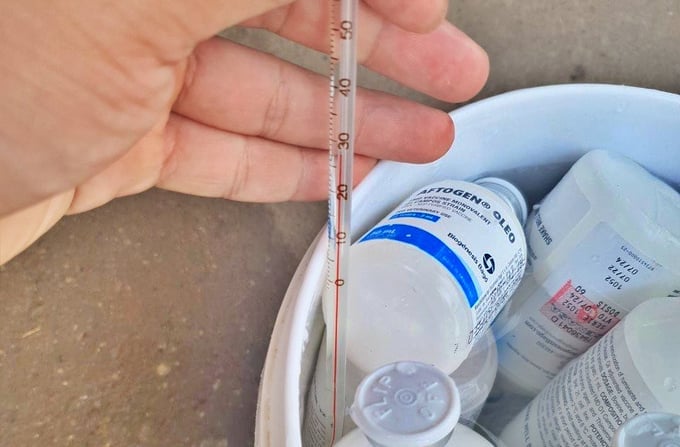November 27, 2025 | 10:26 GMT +7
November 27, 2025 | 10:26 GMT +7
Hotline: 0913.378.918
November 27, 2025 | 10:26 GMT +7
Hotline: 0913.378.918

According to Associate Professor Dr. Nguyen Van Giap, Faculty of Veterinary Medicine under Vietnam National University of Agriculture, there have been significant changes in the official documentation of vaccine efficacy over the years. Photo: PT.
Drawing from the global experience in the fight against foot-and-mouth disease (FMD), Associate Professor Dr. Nguyen Van Giap, Faculty of Veterinary Medicine under Vietnam National University of Agriculture, emphasized that prioritizing the selection of suitable vaccine quality is a paramount factor in the National Program for FMD Prevention and Control.
Additionally, countries and territories which have successfully eradicated the foot-and-mouth disease should still maintain a vaccine stockpile to be prepared for emergencies and disease prevention.
Lessons from global disease control efforts highlighted that vaccines and their quality are the most crucial keys in disease prevention.
Regarding the role of vaccines in the fight against foot-and-mouth disease, Dr. Nguyen Van Giap analyzed that official documentation prior to the early 2000s did not focus on antigen content. However, governmental documents in the last few years have placed a growing emphasis on the high 6PD50 antigen content.
"The reason for this change is that, in the past, the efficacy of vaccines was recognized based on the compatibility of the vaccine strain with the local virus strain. Although Vietnam contained multiple virus strains which are different from the vaccine strain, the vaccines were effective in the protection due to the high 6PD50 antigen content, which can broaden cross-protection against different virus strains within the same serotype," explains Mr. Giap.
According to Dr. Giap, the quality of a vaccine can be analyzed from various aspects such as adjuvants, purity control processes, etc. However, the choice of strains and the increasing antigen levels in each vaccine dose are critical components.
Companies providing foot-and-mouth disease vaccines regularly conduct real efficacy tests against circulating virus strains and publish results every three months. This serves as the basis for farmers to choose effective vaccines, and manufacturers to improve their products in response to practical needs.

Foot-and-mouth disease vaccines with a high 6PD50 antigen content are currently prioritized for use in disease prevention and control by local authorities, businesses, and the veterinary industry. Photo: PT.
According to Dr. Nguyen Van Giap, Vietnam has established numerous regulations for the prevention of foot-and-mouth disease; however, the level of compliance among farmers is also a significant issue for achieving positive outcomes.
Dr. Giap emphasized that the National Program for FMD Prevention and Control from 2021 to 2025 holds significant importance in Vietnam's determination to eradicate the disease and protect livestock herds nationwide.
Regarding the significance of the program after three years of implementation, Dr. Nguyen Van Giap assessed that Vietnam is rapidly reinforcing its connection with many countries around the world. Consequently, Vietnam must approach international standards in the field of disease prevention, with a focus on Foot-and-mouth disease, which poses a high level of danger.
The transportation of animals and animal products from a country suffering from FMD to countries without the disease is strictly prohibited. As a result, Vietnam must focus on building safe and disease-free production areas to develop a safe livestock industry and create broad outlets for products.
According to Mr. Giap, the livestock production industry in Vietnam is developing in an industrial direction, with fewer farms but an increasing number of livestock. If an FMD outbreak occurs within an expansive livestock farm, the disease is capable of causing widespread and significant damage.
In this regard, the Government's National Disease Prevention Program has an indispensable role in protecting the domestic livestock industry.
"Vietnam has both advantages and challenges in the prevention of diseases. Its biggest challenge lies in the inability to strictly control smuggled products through unofficial channels. This is an aspect that the National Disease Prevention Program needs to promptly address," Dr. Nguyen Van Giap recommended.
Nevertheless, Mr. Giap believes that the implementation of vaccines and the selection of highly effective vaccine types are being executed efficiently.
"After animals recover from the foot-and-mouth disease, they will continue to carry and spread the virus. As a result, I would like to advise farmers to comply with isolation procedures, avoid transporting animals or animal products from the affected areas to prevent the emergence of new outbreak areas," Associate Professor Dr. Nguyen Van Giap advised livestock farmers on the prevention of foot-and-mouth disease.
Translated by Nguyen Hai Long
/2025/11/26/4909-2-154329_878.jpg)
(VAN) Pearl grouper farming in HDPE cages not only delivers economic efficiency but also contributes to protecting the environment, creating jobs, and promoting marine-based experiential tourism.

(VAN) The model of making a living under the forest canopy through the agroforestry system in Van Son commune, Bac Ninh province, is expected to generate an annual income of approximately VND 30 million/ha.

(VAN) Many enterprises in Can Tho are harnessing natural energy and reducing greenhouse gas emissions in their production processes, thereby contributing to the promotion of a sustainable green transition.
/2025/11/24/3536-2-112800_176.jpg)
(VAN) Dong Nai now has tens of thousands of hectares of forests certified for sustainable management, and this area will continue to be expanded in the coming period.

(VAN) Vinh Ha hamlet (Dai Xuyen commune, Hanoi) is shifting away from small-scale farming as households adopt bioscurity into their breeder chicken models.

(VAN) Heavy rains make aquatic species more vulnerable to disease. Proactive water management and high-tech systems help farmers prevent outbreaks and protect yields.

(VAN) Greenhouses are shifting production mindsets in Binh Lu commune, enabling farmers to ‘weather the sun and rain’ and secure stable vegetable harvests throughout the year.